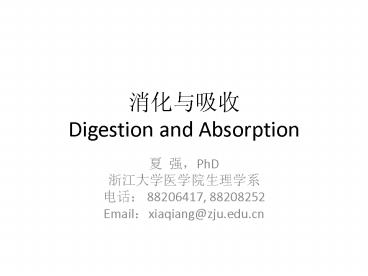????? Digestion and Absorption - PowerPoint PPT Presentation
1 / 74
Title:
????? Digestion and Absorption
Description:
Title: Digestion and Absorption Author: xiaqiang Last modified by: Study Created Date: 8/16/2006 12:00:00 AM Document presentation format – PowerPoint PPT presentation
Number of Views:219
Avg rating:3.0/5.0
Title: ????? Digestion and Absorption
1
?????Digestion and Absorption
- ? ?,PhD
- ???????????
- ?? 88206417, 88208252
- Emailxiaqiang_at_zju.edu.cn
2
????
- ???????????????????????????????????
- ?????
- ?????
- ????????????????,???????????????????????????????
?
3
- ????
- ???
- ???
4
(No Transcript)
5
(No Transcript)
6
???????
- ??Movement
- ??Secretion
- ??Digestion
- ??Absorption
- ??Elimination
7
(No Transcript)
8
Structure of the alimentary canal
9
(No Transcript)
10
- Normal BER frequencies in the gastrointestinal
system
?????basic electrical rhythm BER
11
??????
- ?(??)????
- Enteric nervous system (intrinsic)
- ??(??)????
- Autonomic nervous system (extrinsic)
12
(No Transcript)
13
????Gastrointestinal hormones
- ???????????????????????????????
- ???????????????????
- Gastrointestinal hormones,Gut hormones
14
(No Transcript)
15
?????
16
?????Mastication and swallowing
The swallowing reflex is coordinated by the
medulla oblongata, which stimulates the
appropriate sequence of contraction and
relaxation in the participating skeletal muscle,
sphincters, and smooth muscle groups.
17
The coordinated sequence of contraction and
relaxation in the upper esophageal sphincter, the
esophagus, and the lower esophageal sphincter is
necessary to deliver swallowed food to the
stomach.
18
????
- ??????
- ??????
- ????
- ????
19
(No Transcript)
20
- ??Gastric juice??
- HCl
- ?????Pepsinogen
- ??Mucus
- ????HCO3-
- ???Intrinsic factor
- pH 0.9-1.5
21
(No Transcript)
22
(No Transcript)
23
- ??-??????Mucus-HCO3- barrier
24
(No Transcript)
25
??????(Helicobacter Pylori)
26
????Pancreatic secretion
27
(No Transcript)
28
- ??
- pH 7.88.4
- 1500 ml/day
- Isosmotic
- Components
- Pancreatic digestive enzymes secreted by
pancreatic acini - Sodium bicarbonate secreted by small ductules
and larger ducts
29
(No Transcript)
30
- Secretion of pancreatic digestive enzymes
- Carbohydrates -- Pancreatic amylase
- Pancreatic lipase
- Fat Cholesterol esterase
- Phospholipase
- Trypsinogen
- Proteins Chymotrypsinogen
- Procarboxypolypeptidase
- Proelastase
31
(No Transcript)
32
?????Acute pancreatitis
33
????Secretion of bile by the liver
34
(No Transcript)
35
- ?????
- HCO3-
- Bile salts
- Phospholipids
- Cholesterol
- Bile pigments
36
- ?????
- Emulsifying or detergent function of bile salts
- Bile salts help in the absorption of
- Fatty acid
- Monoglycerides
- Cholesterol
- Other lipids
37
Big Droplets of Fat
Small Droplets of Fat
Micelles
Fatty Acids and Monoglycerides
Chylomicron Assembly
Distribution and Processing
38
(No Transcript)
39
Preventing the cholesterol precipitation
gallstones
40
?????
- ????????
- ???????????B???????K
- ??????????,?????????
41
In the large intestine, active transport of
sodium, coupled with osmotic absorption of water,
are the primary activities. Microbes here are
active in the production of vitamin K.
42
????Defecation reflex
43
? ?Body Temperature
44
? ?
- ??????????????????????????????
- ????Core temperature
- ????Shell temperature
45
Normal core temperature
Site Mean value of temperature Standard deviation Range of variation of temperature
Axillary 36.79oC 0.357 36.0-37.4 oC
Oral 37.19 oC 0.249 36.7-37.7 oC
Rectal 37.47 oC 0.251 36.9-37.9 oC
46
The circadian (about a day) rhythm of body
temperature persists even among patients in a
coma in addition to this basic rhythm, fevers,
exercise, and other activities can alter the body
temperature.
47
(No Transcript)
48
(No Transcript)
49
(No Transcript)
50
Body temperature is a controlled variable that is
subject to homeostatic regulation. This
cartoon indicates some of the ways that
environmental factors can increase or decrease
body temperature.
51
(No Transcript)
52
????
- ???????Autonomic thermoregulation
- ???????Behavioral thermoregulation
53
??????????Hypothalamus
54
?????Renal Physiology
55
(No Transcript)
56
?????
- ?????????,???????
- ??????
- ??????????????????????
- ???
- ???
- ???????(erythropoeitin)
- ??(renin)
- 1,25-??????(1,25-OH2-D3)
- ????,????(PGE2, PGI2)
57
(No Transcript)
58
(No Transcript)
59
(No Transcript)
60
??????????
- ??Filtration
- ???Reabsorption
- ??Secretion
61
Substance X is filtered and secreted but not
reabsorbed.
Substance Y is filtered and some of it is
reabsorbed.
Substance Z is filtered and completely reabsorbed.
62
Composition in the Filtration Fluid
63
Structure of the Filtration Membrane
64
(No Transcript)
65
(No Transcript)
66
???????
- ?????,?????
- ??????????Tm-G
- Tubular transport maximum for glucose
- ???Renal threshold for glucose
- Critical value of the plasma glucose
concentration when the kidney begins to excrete
glucose - 160-180 mg/dL
67
(No Transcript)
68
??
- ??1000-2000ml/24hr
- ??Polyuriagt2500ml/24hr
- ??Oligurialt400ml/24hr,?lt17ml/hr
- ??Anurialt100ml/24hr,?12hr????
69
?????Antidiuretic hormone (ADH)
- ???????Vasopressin
- ?????
- ??????
- ??
- ????????????????
- ????
70
Action of antidiuretic hormone on aquaporin (AQP)
transport. AC, adenylate cyclase AP1,
transcription factor AVP, arginine vasopressin
cAMP, cyclic adenosine monophosphate CRE, cAMP
response element CREB-P, CRE binding protein
EP3, prostaglandin receptor PGE2, prostaglandin
E2. (From Brown D, Nielsen S The cell biology of
vasopressin action. In Brenner BM ed Brenner
and Rectors The Kidney, 7th ed. Philadelphia, WB
Saunders, 2004, p 574.)
71
???Water diuresis ???Diabetes insipidus
72
????Hemodialysis
In a kidney-failure patient undergoing dialysis,
the blood is briefly removed from the body to be
circulated through a dialyzer, where dialysis
fluid and blood move in counter current
directions to remove nitrogenous and other wastes
and adjust osmolarity before the blood is
returned to the body.
73
- ????Peritoneal dialysis
74
??!































